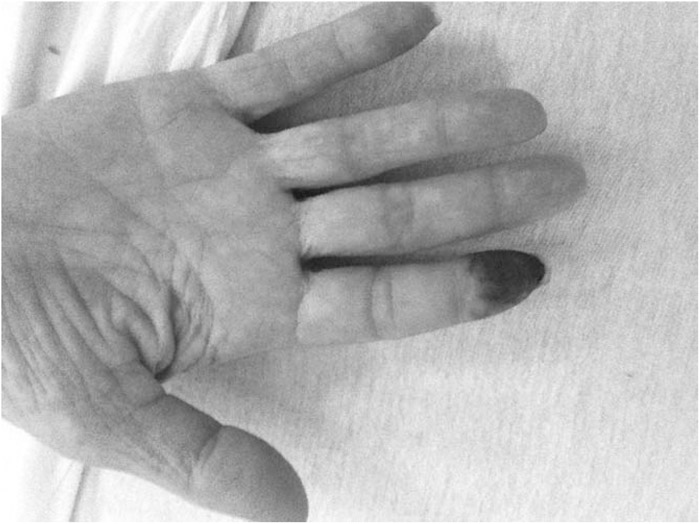Case Presentation:
A 52‐year‐old woman was sent to the hospital by her vascular surgeon for pain and dry gangrene at the tip of the right second digit. Two weeks prior, her symptoms began with a burning sensation, mild ache, and a slight blue discoloration. This progressed to a dark fingertip with worsening pain mildly relieved by holding her finger up to an air‐conditioner. There was no trauma to the finger, fevers, or local infection. She is an active smoker with a medical history of right breast lumpectomy for a benign mass in 1992. Her only medication was over‐the‐counter ibuprofen. Physical exam showed a black tip of the right index finger with well‐defined borders at the distal interpha‐langeal joint. Pulses were full in all limbs. A grade II/VI systolic murmur was heard at the left sternal border. No splenomegaly was noted. Laboratory values showed normo‐cytic anemia, platelets of 1000 × 103/μL, with an elevated white blood cell count of 20 × 103/μL. Coagulation times were normal. A heparin drip was started for presumed arterial thrombus. Cultures were negative for infection. Electrocardiogram showed no dysrhythmias. CT scan with IV contrast revealed no pulmonary embolus, deep vein thrombosis, aortic dissection, or aneurysm. No regurgitant valves, thrombi, or vegetations were seen on transesophageal echocardiogram. JAK2 and BCR/Abl mutations were not detected. Given the thrombocythemia with no obvious source of infection or chronic inflammation, a diagnosis of essential thrombocythemia (ET) was made. She was started on hydroxyurea (HU) and low‐dose aspirin. After 7 days of therapy, platelet counts improved to 851 × 103/μL. The patient began to have pain in the right fifth digit with mottling, and aspirin was increased to 325 mg and HU was continued.
Discussion:
ET is a rare myeloproliferative disorder in which a clonal defect causes sustained production of megakaryocytes and an abnormal rise in platelets over 600 × 103/μL. Most thrombocythemias are reactive to the systemic inflammatory process. ET comprises fewer than 10% of all thrombocythemias. The annual incidence is 2–3 per 100,000 people. Among reported cases of ET, studies show 11%–25% with thrombotic complications. Erythromelalgia is a burning sensation with swelling and redness of the extremities. It is a common presentation in thrombosis related to ET and may occur with or without ischemia. Treatment for symptomatic ET include low‐dose aspirin for antiplatelet and HU for platelet‐lowering strategies. Studies have shown long‐term benefits from HU therapy. These are typically achieved in a median of 30 days.
Conclusions:
Limb ischemia is a common indication for hospital admission. However, solitary, well‐demarcated digital ischemia in the absence of a systemic inflammatory process deserves a narrower differential. Although rare, hospitalists need to be familiar with the complications of ET and its treatment.
Disclosures:
M. J. Lee ‐ none; F. Khan ‐ none; K. Glockenberg ‐ none; A. Burger ‐ none

